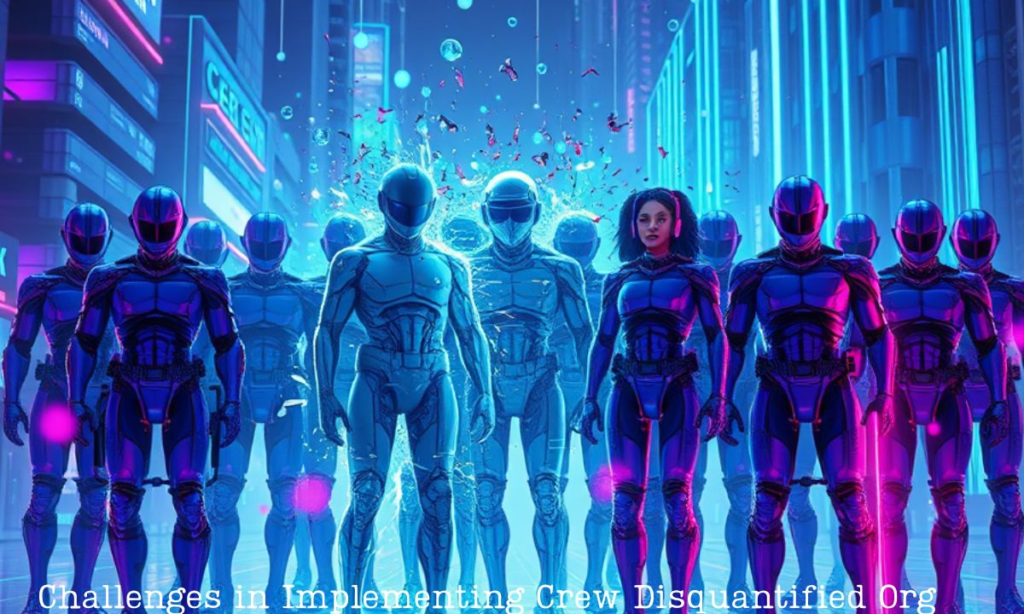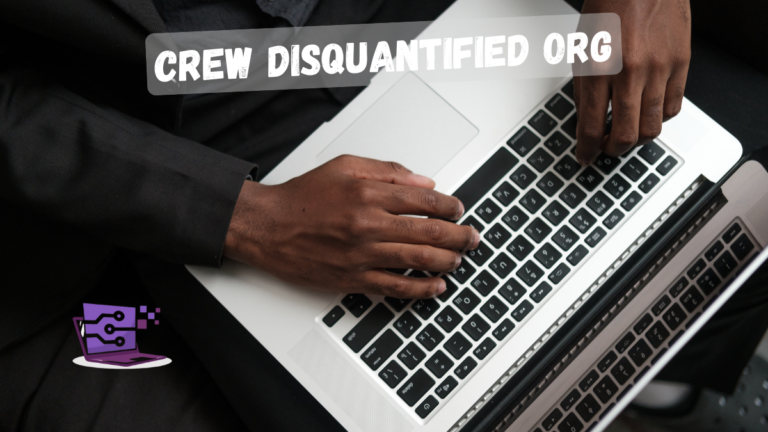In the ever-evolving world of organizations, a new concept is rapidly gaining attention – Crew Disquantified Org. This innovative organizational model is revolutionizing the way teams operate, pushing boundaries in terms of structure, collaboration, and efficiency. In this article, we explore the core principles behind Crew Disquantified Org, its benefits, challenges, and the transformative impact it can have on the future of work.
What is Crew Disquantified Org?
To fully understand what Crew Disquantified Org means, it’s essential to first break down the term itself. “Crew” refers to a group of individuals working together toward a common goal, while “Disquantified” hints at a departure from traditional, rigid metrics and hierarchies. Put together, Crew Disquantified Org represents an organization that values collaboration, flexibility, and creativity over rigid structures and standardized measurement systems.
This model challenges conventional organizational designs that often prioritize hierarchy, predetermined roles, and efficiency metrics. Instead, Crew Disquantified Org emphasizes agility, adaptability, and a focus on the collective strengths of the team rather than individual performance. By reducing reliance on traditional structures, it fosters an environment where innovation can thrive.
The Core Principles of Crew Disquantified Org
At its foundation, the Crew Disquantified Org model is built on several key principles that distinguish it from traditional organizational frameworks. These include:

1. Fluid Team Structures
In a Crew Disquantified Org, team structures are not fixed. Unlike traditional organizations, where individuals are often assigned to predefined roles, teams within a Crew Disquantified Org can shift and adapt based on the current needs of the project or organizational goals. This fluidity encourages flexibility and creativity, enabling the organization to respond to changes quickly.
2. Decentralized Decision-Making
Centralized decision-making can stifle innovation and slow down progress. A Crew Disquantified Org embraces decentralization, allowing teams and individuals to make decisions autonomously. By empowering members at all levels to contribute to decision-making processes, organizations foster a sense of ownership, accountability, and motivation.
3. Performance Beyond Numbers
Traditional organizations often focus on numerical performance metrics such as revenue, sales, or efficiency. In contrast, Crew Disquantified Org values outcomes over outputs. Performance is measured not by numbers alone, but by the quality of collaboration, innovation, and problem-solving abilities that drive the organization forward.
4. Emphasis on Collaboration
At the heart of Crew Disquantified Org is the emphasis on collaboration. Traditional organizations often operate in silos, where departments or teams work in isolation from one another. In contrast, the Crew Disquantified Org model encourages cross-functional collaboration, where teams can draw upon diverse skill sets and perspectives to solve problems and achieve common goals.
5. Adaptation and Innovation
In a rapidly changing world, organizations need to be able to adapt quickly to new challenges and opportunities. The Crew Disquantified Org model fosters a culture of continuous learning and innovation. With flexible structures and decentralized decision-making, organizations are more agile and better equipped to pivot when necessary.
Benefits of Adopting the Crew Disquantified Org Model

1. Increased Agility and Responsiveness
One of the key benefits of Crew Disquantified Org is the ability to respond swiftly to market changes, customer feedback, or emerging trends. With fluid team structures and decentralized decision-making, the organization can adapt and pivot quickly, ensuring that it remains competitive in a fast-moving business environment.
2. Enhanced Creativity and Innovation
By emphasizing collaboration and allowing teams to form organically based on the needs of the project, a Crew Disquantified Org can unleash a wave of creativity and innovation. The flexibility inherent in this model encourages individuals to think outside the box, experiment, and push boundaries, leading to groundbreaking ideas and solutions.
3. Improved Employee Engagement and Satisfaction
In a Crew Disquantified Org, employees have more control over their work and the direction of the organization. The decentralized decision-making process empowers individuals to take ownership of their tasks, resulting in higher levels of engagement and job satisfaction. Moreover, the focus on collaboration and innovation fosters a sense of purpose and fulfillment, contributing to lower turnover rates.
4. Breaking Down Silos
Traditional organizations often suffer from siloed thinking, where departments or teams fail to communicate or collaborate effectively. Crew Disquantified Org breaks down these barriers, fostering a more cohesive and integrated work environment. By encouraging cross-functional collaboration, organizations can leverage a wider range of expertise and skills, resulting in better outcomes.
5. Attracting Top Talent
In today’s competitive job market, talented professionals are increasingly seeking work environments that allow for flexibility, creativity, and autonomy. The Crew Disquantified Org model offers a unique value proposition to potential employees, positioning the organization as an attractive destination for top talent. The focus on employee empowerment and innovative thinking appeals to those who seek a more dynamic and fulfilling work experience.
Challenges of Implementing Crew Disquantified Org
Despite its many advantages, the implementation of a Crew Disquantified Org is not without challenges. Organizations may encounter several obstacles as they transition from traditional models to this more fluid and decentralized structure.
1. Resistance to Change
One of the biggest challenges in adopting the Crew Disquantified Org model is resistance to change. Employees who are accustomed to traditional hierarchical structures may struggle to adapt to the new way of working. Overcoming this resistance requires strong leadership, clear communication, and a commitment to supporting employees through the transition.
2. Managing Complexity
As organizations become more fluid and decentralized, managing complexity can become a challenge. Without clear roles and responsibilities, it can be difficult to ensure that tasks are completed efficiently and that everyone is aligned with organizational goals. To address this, Crew Disquantified Org organizations must invest in robust communication and coordination tools to maintain clarity and alignment.
3. Maintaining Accountability
In a decentralized environment, maintaining accountability can be difficult. Without clear lines of authority or performance metrics, it may be challenging to ensure that individuals are meeting their responsibilities. It is crucial for Crew Disquantified Org organizations to establish mechanisms for monitoring progress and holding individuals accountable without relying on traditional top-down oversight.
4. Balancing Flexibility with Structure
While flexibility is a key strength of the Crew Disquantified Org model, too much fluidity can lead to a lack of structure and direction. Organizations must find a balance between empowering individuals to make decisions and maintaining enough structure to ensure that goals are met and that the organization remains aligned.
How to Implement a Crew Disquantified Org
Implementing a Crew Disquantified Org requires careful planning and a thoughtful approach. Below are some steps organizations can take to successfully transition to this innovative model:
1. Redesign the Organizational Structure
The first step is to redesign the organization’s structure to allow for fluid team formation and decentralized decision-making. This may involve eliminating rigid hierarchies and allowing teams to form and dissolve as needed. Leaders should focus on creating a supportive environment that encourages collaboration and empowers individuals at all levels.
2. Foster a Culture of Innovation
For a Crew Disquantified Org to succeed, organizations must foster a culture of innovation. This involves encouraging experimentation, risk-taking, and continuous learning. Leaders should create an environment where employees feel safe to propose new ideas and challenge the status quo.
3. Invest in Communication and Collaboration Tools
Effective communication is crucial in a decentralized organization. Organizations should invest in tools that enable seamless communication and collaboration across teams, regardless of their structure. This includes project management tools, video conferencing software, and collaboration platforms that facilitate real-time communication and information sharing.
4. Provide Support and Training
Transitioning to a Crew Disquantified Org model can be challenging, especially for employees who are accustomed to traditional ways of working. Providing support and training is essential to ensure that everyone understands the new way of working and is equipped with the skills and knowledge to succeed in this environment.
5. Measure Success Based on Outcomes
Instead of focusing on traditional performance metrics, organizations should measure success based on outcomes and the overall impact of collaboration and innovation. This includes evaluating how well teams work together, the quality of ideas generated, and the degree to which the organization is able to adapt to changing circumstances.
Conclusion: The Future of Work
The Crew Disquantified Org model represents a bold departure from traditional organizational structures. By embracing flexibility, decentralization, and collaboration, organizations can unlock new levels of creativity, agility, and innovation. However, transitioning to this new model requires careful planning, a commitment to cultural change, and a willingness to embrace uncertainty.
As the future of work continues to evolve, the Crew Disquantified Org model offers a glimpse into a more dynamic and collaborative way of working. It challenges traditional norms and encourages organizations to rethink how they operate, collaborate, and innovate in a fast-paced world. The rise of Crew Disquantified Org signals the dawn of a new era in organizational design – one that prioritizes people, creativity, and adaptability over rigid structures and outdated metrics.
For more information visite the website

